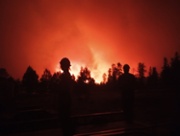|
|
|
|
 
|
Today's News
|
 |
| Dragon Bravo Fire at Grand Canyon National Park in July. (Grand Canyon National Park via Getty Images) |
Major wildfires are increasingly disrupting water systems in the Western US, causing direct damage to infrastructure such as treatment facilities, pipelines and storage tanks. One example is the Dragon Bravo Fire at the Grand Canyon, which resulted in a chlorine gas leak at the park's water treatment facility, damaged water pipes and raised contamination concerns. The growing frequency and severity of wildfires underscore the urgent need to modernize vulnerable water infrastructure and integrate water utilities into emergency response planning.
|

|
Successful projects deliver immediate results and lasting impact. At PCL, we don't just build resilient water infrastructure projects; we also build trust and partnerships that evolve with our clients' needs, ensuring support and reliability beyond project completion.
Learn how PCL builds trust.
|
|
|
|
|
|
 
Environmental Protection
More than 550 drinking water wells near military facilities in Washington state are contaminated with PFAS, according to an analysis of Defense Department testing conducted over the past two years. The testing involved 866 private wells in total. The contamination is linked to decades of firefighting foam use on bases, and communities near installations like Yakima Training Center and Naval Air Station Whidbey Island are among those most affected.
|
 | Transforming Retail With FWA
Retailers are deploying innovative technologies to improve customer experiences. This paper explores challenges in retail and how fixed wireless access (FWA) offers the infrastructure needed to support innovation. |
|---|
| |
|
|
 
Circular Water Economy
Many leading tech companies do not fully disclose the amount of water their data centers consume, and available data often lacks consistency and detail, write Peyton McCauley and Melissa Scanlan of the University of Wisconsin-Milwaukee. The Lawrence Berkeley National Laboratory estimates that data centers in the US consumed 17 billion gallons of water directly for cooling in 2023, a figure that could quadruple by 2028. In this piece, McCauley and Scanlan discuss the lack of transparency in data center water use and how to correct it.
|
 | Sales Reimagined: Delivering Real Impact
AI is changing sales. Join leaders from BCG, Salesforce, and Workday for a fireside chat on how to navigate the agentic era and reshape your sales teams for the future. Discover how to embed AI across the sales experience and lead hybrid teams of human talent augmented by digital agents. Register now to learn how to drive tangible impact and prepare your sales organization for what's next. |
|---|
| |
|
|
 
Free eBooks and Resources
|
 
Infrastructure Watch
New buildings in designated parts of Macau could be required to install reclaimed water piping under new regulations aimed at promoting treated wastewater use. The regulation also enhances flood prevention and drainage systems to handle severe rainfall events. The city aims for reclaimed water to supply up to 10% of its total water needs by 2034.
|
Water Environment Research
|
Funding and Financing
|
 |
| Colorado River (Mladen Antonov/AFP/Getty Images) |
Congressional stalemate has left the future of the System Conservation Pilot Program uncertain, with a reauthorization bill passing the Senate in June but stalling in the House. The program, designed to pay water users in four Western states to voluntarily reduce water consumption, was re-launched in 2022 with $125 million from the Inflation Reduction Act. After initial runs from 2015 to 2018 and a rapid restart in summer 2023, it boosted participation among Colorado farmers and ranchers, especially on the Western Slope.
|
Stormwater
Harris County, Texas, is considering a $30 billion flood mitigation project involving the construction of 133 miles of tunnels, some as deep as 120 feet, to move water from nearly 50% of the county's watersheds to the ship channel. The Harris County Flood Control District has spent $4.5 million on studies and is seeking federal funding through the Solutions for Advancing Floodplain Evaluation and Resilience Study.
| | | | |
